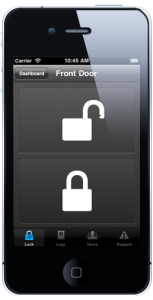Use Your Phone to Unlock Doors with Lockitron
Time to read:
This post is part of Twilio’s archive and may contain outdated information. We’re always building something new, so be sure to check out our latest posts for the most up-to-date insights.

Lockitron is a product by Apigy that allows you to lock and unlock doors using only your phone. All you need to do is install a Lockitron-powered lock or doorknob that is connected to your home router. With the Lockitron app, you can now lock and unlock your door. As an added service, you can also use SMS (powered by Twilio!) to do the same. The coolest feature, though, is the ability to give remote access to friends or guests so they can enter on their own using the app or SMS. Check out the intro video below.
[youtube width=”640″ height=”360″]https://www.youtube.com/watch?v=mQCJgx_kofo[/youtube]
We love hardware mashups with the Twilio API, so we caught up with Apigy co-founder Cameron Robertson to talk about Lockitron’s Twilio integration.
What is the backstory of Lockitron?

We’ve been working on Lockitron for just over a year now and we are starting to discover some really interesting things about the way users engage with the product. It turns out that Lockitron adds a new dimension of utility when it comes to accessing your business or home. Just as mailing floppy diskettes and compact discs prior to the mass adoption of the internet was an inefficient way to send small amounts of data, mailing or handing off keys sucks as a method of sharing access.
What are your future plans for Lockitron?
Our main focus is to make the user’s experience with Lockitron as seamless as possible, whether when installing the product, using it on a daily basis or sharing Lockitron keys with friends and family. On the messaging end, this means building clever notifications that let the owner of a lock know when guests arrive for the first time or warnings if their Lockitron isn’t working properly.
What technologies are you using to build and support Lockitron?
Since Lockitron spans mobile, the web and our hardware, it is based on a wide range of technologies that include Ruby on Rails, jQuery, Perl and C.
How did you get started developing with Twilio?
While many Lockitron users have a smartphone, they frequently invite family and friends who may or may not have one. Given that nearly every mobile phone can send and receive text messages, adding text message access vastly expands who can use Lockitron.
Twilio’s API turned out to be the quickest and easiest way to get up and running – the fact that it is cost competitive as well is icing on the cake.
How was the experience of integrating Twilio with your chosen tools and technologies?
Integrating Twilio went incredibly fast – if you can build an endpoint that accepts POST requests there is no reason you shouldn’t be able to have an integrated “Hello World” up and running in five minutes.
Thanks Cameron for taking the time to chat with us and best of luck with Lockitron! For more info, visit their website or shoot Cameron a tweet at @ccamrobertson
Related Posts
Related Resources
Twilio Docs
From APIs to SDKs to sample apps
API reference documentation, SDKs, helper libraries, quickstarts, and tutorials for your language and platform.
Resource Center
The latest ebooks, industry reports, and webinars
Learn from customer engagement experts to improve your own communication.
Ahoy
Twilio's developer community hub
Best practices, code samples, and inspiration to build communications and digital engagement experiences.